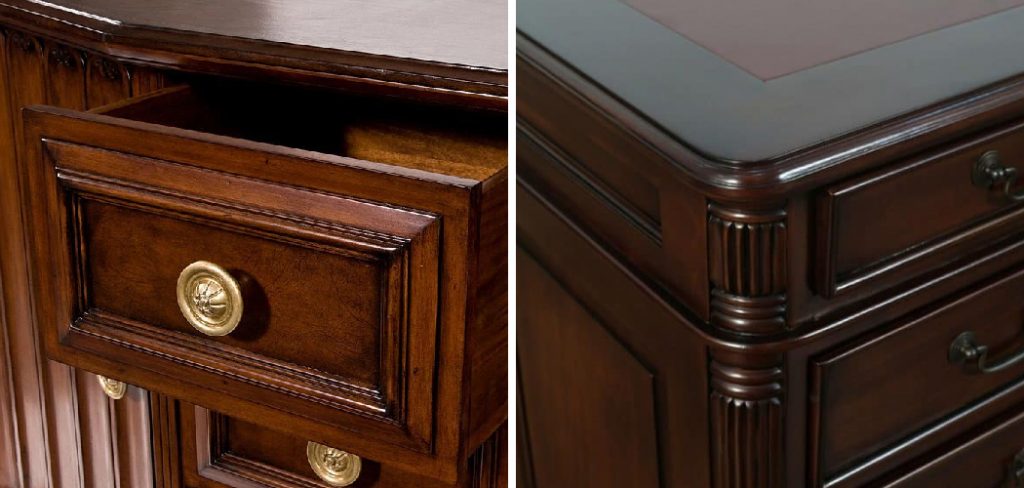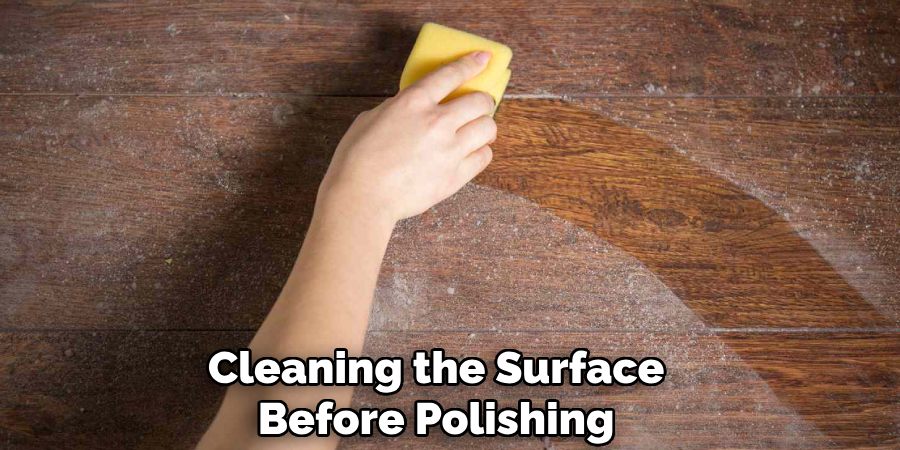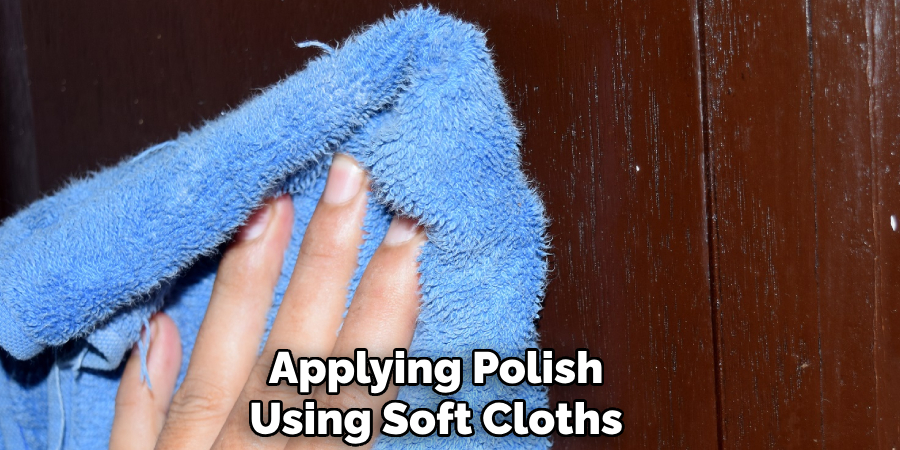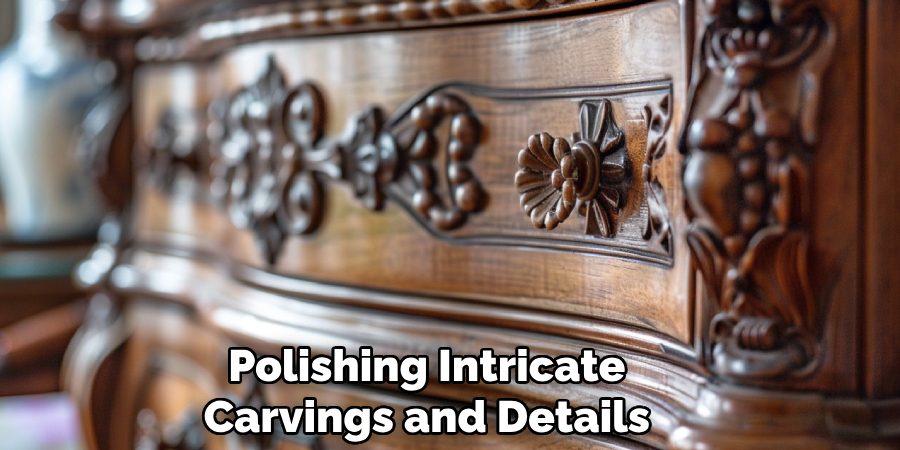Polishing mahogany bedroom furniture not only preserves its natural beauty but also extends its longevity. Known for its rich color and fine grain, mahogany is a prized material that requires proper care to maintain its elegant appearance.

With the right techniques and materials, you can ensure that your mahogany furniture remains a stunning centerpiece in your home for years to come. This guide will walk you through the essential steps of how to polish mahogany furniture.
Importance of Regular Polishing
Regular polishing is crucial to maintaining the natural luster and durability of mahogany furniture. Over time, dust, dirt, and environmental factors can dull the furniture’s surface, diminishing its aesthetic appeal. Polishing not only restores the shine but also helps to protect the wood from scratches, moisture, and wear.
By applying a high-quality polish, you can nourish the wood, enhance its grain, and create a barrier that preserves its rich color. Meanwhile, consistent care ensures that your furniture remains a timeless piece that adds elegance to any space.
Understanding Mahogany Wood
Mahogany wood is highly prized for its durability, beauty, and versatility. Known for its rich reddish-brown hue and straight, fine grain, mahogany is often used in high-quality furniture, cabinetry, and decorative pieces. This hardwood is naturally resistant to pests and decay, which contributes to its longevity and makes it a popular choice for heirloom furniture.
Additionally, its ability to be finely sanded and polished enhances its luxurious appearance, while its stability ensures that it resists warping and shrinking over time. Understanding the characteristics of mahogany allows homeowners and craftsmen to fully appreciate and maximize its value in various applications.
Supplies You’ll Need
When working with mahogany, having the right supplies is essential to achieve the best results. Here are some key materials and tools you’ll need:
- High-quality sandpaper in varying grits (e.g., 120, 220, and 320) for smoothing the surface.
- Wood glue for strong and durable joints in furniture making.
- A fine-toothed saw to ensure clean cuts without splintering.
- Clamps to hold pieces securely while glue dries or during assembly.
- Wood stain or finish to enhance the color and protect the wood.
- Soft cloths or brushes for applying stains, finishes, and polishes evenly.
- Dust masks and protective eyewear to ensure safety while sanding or cutting.
Having these supplies on hand will help you work efficiently and effectively, whether crafting furniture or completing a smaller woodworking project.
10 Methods How to Polish Mahogany Furniture
1. Cleaning the Surface Before Polishing
To achieve a brilliant polish on mahogany furniture, begin by thoroughly cleaning the surface. Dust and grime can interfere with the polishing process, so use a soft, lint-free cloth to wipe away loose particles. For deeper cleaning, mix a mild solution of warm water and a few drops of gentle dish soap. Dampen a cloth with this mixture—never soaking wet—and carefully wipe down the wood.

Pay close attention to areas with intricate carvings or corners where dust accumulates. After cleaning, immediately dry the surface with a separate clean cloth to prevent moisture damage. This preliminary cleaning ensures that the polish will adhere properly and that the final finish will be smooth and lustrous.
2. Choosing the Right Polish for Mahogany
Selecting the appropriate polish is crucial for maintaining the rich, deep tone of mahogany. Traditional wax polishes, especially those containing beeswax or carnauba wax, are excellent for protecting the wood while enhancing its natural glow. Alternatively, oil-based polishes, such as those containing linseed or tung oil, penetrate deeply, nourishing the wood from within.
Avoid silicone-based products, as they can leave a filmy residue that dulls the finish over time. Always test a small, inconspicuous area before applying the chosen product to the entire surface. Using the right polish preserves the wood’s integrity and highlights its natural grain and sheen.
3. Applying Polish Using Soft Cloths
To achieve a streak-free shine, use soft, lint-free cloths when applying polish. Microfiber or cotton cloths work best as they absorb excess polish and distribute it evenly. Dampen the cloth slightly with the polish, ensuring it is not overly saturated. Start by applying the polish in small, circular motions, moving with the grain of the wood to avoid leaving swirl marks.
Work in sections, particularly if the piece is large, to ensure even coverage. Buff each section lightly as you move along to help the polish penetrate the wood fibers. Consistent, gentle pressure ensures a smooth, uniform finish.

4. Buffing to a High Gloss Finish
Once the polish has been evenly applied, allow it to sit for a few minutes to penetrate the wood. Then, use a fresh, dry cloth to buff the surface. Move in circular motions, applying moderate pressure to enhance the sheen. For an extra glossy finish, repeat the buffing process with a new cloth, ensuring that any excess polish is completely absorbed.
The key to a mirror-like shine is thorough buffing, which brings out the depth of the mahogany’s natural color. Regularly replacing the cloth during buffing prevents streaking and ensures that no residual polish remains on the surface.
5. Using Homemade Polish for a Natural Shine
Homemade polishes can be a cost-effective and environmentally friendly alternative. One popular recipe includes equal parts olive oil and white vinegar. Mix thoroughly and apply with a soft cloth, working it into the wood in the direction of the grain. Another option is a blend of lemon juice and linseed oil, which not only polishes but also revitalizes the wood.
After application, let the mixture sit for about 10 minutes before buffing it out with a dry cloth. Homemade polishes are particularly beneficial as they are free from harsh chemicals, leaving behind a natural, subtle fragrance and a deep, radiant gloss.
6. Treating Scratches and Dull Spots
Scratches and worn areas can detract from mahogany’s natural elegance. To minimize these imperfections, use a color-matched furniture touch-up marker or a commercial scratch repair product. For minor surface scratches, a mixture of ground coffee and olive oil can be dabbed onto the affected area.
Allow it to sit briefly before wiping off the excess. Follow up by polishing the entire surface to blend the repair seamlessly. Regular touch-ups and consistent maintenance prevent minor blemishes from becoming more pronounced, keeping the furniture looking pristine.
7. Polishing Intricate Carvings and Details
Mahogany furniture often features ornate carvings that require special attention during polishing. To effectively polish these areas, use a small, soft-bristle brush, such as a paintbrush or a toothbrush, to work the polish into the crevices. Avoid overloading the brush with polish, as excess product can accumulate and harden.

After application, use a clean, dry brush to remove any residual polish from tight spaces. Polishing carved areas separately from flat surfaces ensures that every detail is treated, maintaining the craftsmanship’s integrity and highlighting the intricate woodwork.
8. Regular Maintenance to Preserve Shine
Routine care is essential to maintain the polished finish of mahogany furniture. Dust weekly with a soft cloth to prevent the buildup of abrasive particles. Periodically reapply polish, especially in high-traffic areas where the finish may wear down.
Avoid using water directly on the wood, as moisture can cause the finish to cloud or even warp the wood over time. Placing the furniture away from direct sunlight also helps preserve its rich color and sheen. By incorporating these practices into regular upkeep, the furniture will retain its polished appearance for years.
9. Preventing Damage from Environmental Factors
Mahogany furniture is sensitive to changes in humidity and temperature, which can affect its polished surface. To minimize damage, keep the furniture away from radiators, heating vents, and air conditioning units. Use a humidifier during winter months to maintain a stable environment, preventing the wood from drying out and the finish from cracking.
Placing coasters and placemats on surfaces reduces the risk of water rings and scratches. By controlling the environment around your mahogany pieces, you safeguard their polished beauty against the effects of climate fluctuations.
10. Restoring Dull or Faded Polished Surfaces
Over time, even well-maintained mahogany furniture may lose its luster. To restore its original glow, perform a deep clean to remove old polish residues and contaminants. Use a wood cleaner specifically formulated for mahogany to break down built-up wax and dirt.
After cleaning, apply a nourishing wood conditioner to revitalize the fibers before reapplying a fresh coat of polish. Allow the conditioner to absorb fully, and then follow the standard polishing and buffing procedure. Restoring dull surfaces not only enhances appearance but also protects the wood from further deterioration.

Conclusion
Polishing mahogany furniture is more than just a cosmetic task—it’s an essential part of preserving its luxurious appearance and structural integrity. By selecting the right products, applying them with care, and maintaining the polished surface regularly, you ensure the enduring beauty of your mahogany pieces.
Whether using commercial polishes or natural homemade alternatives, the key is consistency and attention to detail. Thanks for reading our blog post on How to polish mahogany furniture! We hope you found it helpful and informative.
About the Author
Adrian Green, a lifelong woodworking enthusiast, shares his passion for the craft through The Woodenify Blog. With a foundation built on years of hands-on experience in his father’s woodworking shop, Adrian is dedicated to helping others learn and grow in the world of DIY woodworking. His approach to woodworking combines creativity, practicality, and a deep appreciation for the art of building with your own hands. Through his blog, he inspires individuals of all skill levels to embark on their own woodworking journeys, creating beautiful, functional pieces of furniture and décor.
Professional Focus
- Specializes in DIY woodworking projects, from furniture to home décor.
- Provides step-by-step guides and practical tutorials for woodworkers of all skill levels.
- Dedicated to helping readers build confidence and skill through easy-to-follow instructions and tips.
- Passionate about fostering a community of makers who can share, learn, and grow together.
Education History
- University of Craft and Design – Bachelor of Fine Arts (BFA) in Woodworking and Furniture Design
- Woodworking Apprenticeships – Extensive hands-on training with skilled craftsmen to refine carpentry and furniture making techniques.
- Online Courses & Masterclasses – Continued education in advanced woodworking techniques, design principles, and specialized tools
Expertise:
- DIY woodworking, carpentry, furniture making, and home décor projects.
- Creating accessible tutorials and guides for beginner to advanced woodworkers.
- Sharing the joys and satisfaction of woodworking, from raw materials to finished products.
